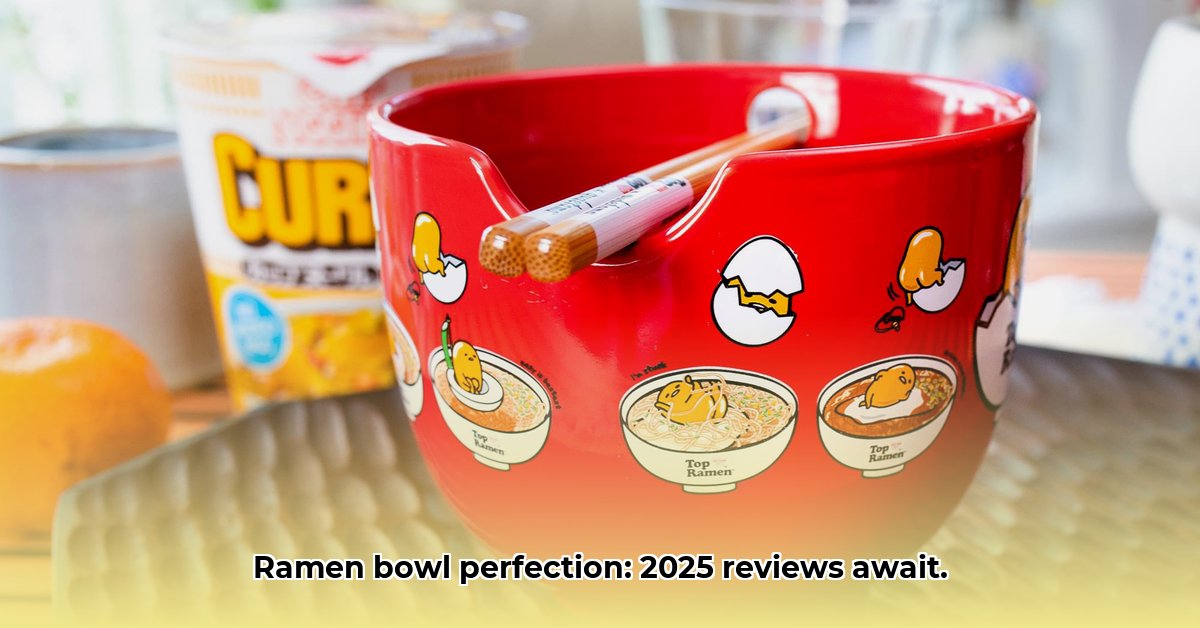Ready to elevate your ramen experience? Choosing the right ramen bowl set can significantly enhance your enjoyment of this beloved dish. This comprehensive guide will navigate you through the key considerations, from material and size to style and care, ensuring you find the perfect set to slurp in style.
Ramen Bowl Set: Your Guide to Noodle Nirvana
The right ramen bowl is more than just a container; it’s an integral part of the overall ramen experience. Selecting the perfect set can transform your dining sessions from ordinary to extraordinary. This guide will navigate you through the nuances of ramen bowls, ensuring you discover the ideal match for your preferences and aesthetic. Prioritize material, size, and style choices for maximum value.
The Great Ramen Bowl Material Debate: Ceramic vs. Melamine
The first major decision lies in the material. Ceramic, melamine, porcelain, and even stoneware are common choices, each with distinct advantages.
Ceramic: Exudes elegance, boasts beautiful designs, and excels at keeping ramen steaming hot. Perfect for a cozy, comforting experience on a chilly evening. However, ceramic can be delicate and prone to chipping.
Pros of Ceramic:
- Superior Heat Retention: Keeps ramen delightfully hot for longer.
- Aesthetically Pleasing: Offers diverse styles, colors, and intricate designs.
- Often Feels More Premium: Provides a luxurious and authentic feel.
- Microwave Safe: Most ceramic bowls are microwave safe (always check the label).
Cons of Ceramic:
- Fragile: Prone to breakage, chipping, and cracking.
- Often Hand-Wash Only: Some may require more careful cleaning.
- Can be More Expensive: Generally carries a higher price tag than melamine.
- Thermal Shock: Sudden temperature changes can cause cracking.
Melamine: The workhorse of ramen bowls, known for its durability and resistance to drops and bumps. Melamine is also typically dishwasher-safe, making cleanup a breeze. However, it might lack the sophisticated look and heat retention of ceramic.
Pros of Melamine:
- Unbreakable: Ideal for households with children or accident-prone individuals.
- Dishwasher Safe: Simplifies cleanup significantly.
- Budget-Friendly: Generally more affordable than ceramic or porcelain.
- Lightweight: Easy to handle and store.
- Stain Resistant: Less prone to staining compared to some other materials.
Cons of Melamine:
- Less Heat Retention: Ramen might cool faster.
- Less Elegant: Might not appear as refined as ceramic or porcelain.
- Not Always Microwave Safe: Always verify before microwaving, as some can leach chemicals.
- Can Scratch Easily: Utensils can leave visible scratches on the surface.
Porcelain: A refined type of ceramic known for its smooth, non-porous surface and elegant appearance. Porcelain offers a good balance of heat retention and durability.
Pros of Porcelain:
- Excellent Heat Retention: Similar to ceramic, keeps ramen hot.
- Elegant Appearance: Offers a sophisticated, high-end look.
- Durable: More chip-resistant than standard ceramic.
- Microwave and Dishwasher Safe: Typically safe for both (always verify).
- Non-Porous: Doesn’t absorb flavors or odors.
Cons of Porcelain:
- More Expensive: Generally pricier than ceramic and melamine.
- Can Still Break: While more durable, it’s still susceptible to breakage.
- May Require Gentle Handling: Avoid harsh scrubbing to preserve the finish.
Stoneware: A rustic and durable option, stoneware ramen bowls offer a unique aesthetic and excellent heat retention.
Pros of Stoneware:
- Excellent Heat Retention: Keeps ramen warm for extended periods.
- Durable: More resistant to chipping and cracking than ceramic.
- Rustic Aesthetic: Offers a charming, earthy appearance.
- Microwave and Dishwasher Safe: Typically safe for both (always verify).
Cons of Stoneware:
- Heavier: Can be heavier to handle than other materials.
- Porous: May absorb flavors and odors over time if not properly glazed.
- Can be More Expensive: May be pricier than ceramic and melamine, but often more affordable than porcelain.
The optimal material depends on your priorities: warmth and beauty with careful handling, or durability and convenience above all else? Consider your lifestyle, budget, and aesthetic preferences when making your choice.
Ramen Bowl Sizes: Finding Your Perfect Portion
Ramen bowl sizes vary dramatically. Choosing a size that’s comfortable to hold and perfectly suits your ramen serving is crucial for an enjoyable dining experience.
| Bowl Size (approximate capacity) | Typical Ramen Portion | Best For: | Example Usage |
|---|---|---|---|
| Small (12-16 oz / 350-470 ml) | Small/Single Serving | Light eaters, kids | Appetizer portions, children’s meals |
| Medium (18-24 oz / 530-710 ml) | Standard Serving | Average eaters | Standard ramen servings, everyday use |
| Large (28-36 oz / 830-1060 ml) | Large/Sharing Portion | Hearty eaters, sharing | Generous portions, ramen with extra toppings |
| Extra Large (40+ oz / 1180+ ml) | Extra Large | Ramen Enthusiasts | Ramen with extra broth and toppings, Udon, Pho |
Consider your typical ramen consumption, desired amount of toppings, and broth preference to select the right capacity and enhance your ramen experience. Also, think about the size of your dishwasher and storage space.
Ramen Bowl Styles: Aesthetics that Enhance the Experience
Beyond material and size, the style of your ramen bowl set matters. From minimalist and modern to traditional Japanese designs, the options are endless. Choose a bowl that elevates the experience and complements your kitchen décor.
A wide spectrum of styles is available, ranging from sleek, modern designs to rustic and traditional bowls evoking Japanese heritage. The right bowl set can transform a simple meal into an aesthetically pleasing ritual. Consider these styles:
- Traditional Japanese: Often features intricate patterns, dark colors, and a slightly textured surface. Look for elements like cherry blossoms, dragons, or wave motifs.
- Modern Minimalist: Emphasizes clean lines, simple shapes, and neutral colors like white, gray, or black.
- Rustic/Earthy: Showcases natural textures, earthy tones, and a handmade feel.
- Whimsical/Colorful: Incorporates bright colors, playful patterns, and fun designs.
- Restaurant-Style: Mimics the bowls used in ramen restaurants, often featuring a classic shape and a durable construction.
- Noodle Bowls with Handles: Some bowls come with handles to allow ease of use lifting the bowl.
- Bowls with Chopstick Rest: Some bowls offer built in chopstick rest on the side so your chopsticks dont roll off the table.
Top Ramen Bowl Set Picks (Illustrative Examples)
While specific product recommendations require dedicated reviews, remember these style categories while shopping:
- Elegant Ceramic Sets: If prioritizing a premium look and feel is important, look for high-quality ceramic sets with intricate designs and a smooth finish.
- Durable Melamine Sets: Ideal for busy lifestyles, offering resilience and easy cleaning. Choose melamine sets with a simple, modern design for a stylish yet practical option.
- Large-Capacity Family Sets: Great for sharing and generous portions. Opt for stoneware or porcelain sets with a large capacity and a rustic or traditional design.
- Modern Minimalist Sets: Enhance a contemporary kitchen look with simplistic designs. Look for sets with clean lines, neutral colors, and a matte finish.
Actual product names and purchase links are typically featured in detailed reviews.
Your Ramen Bowl Set Checklist: Before You Buy
Before making a purchase, consider these important factors:
- Material: Ceramic (elegant but fragile), melamine (durable but less heat retention), porcelain (elegant and durable), stoneware (rustic and excellent heat retention).
- Size: Choose a capacity that suits your ramen appetite and the typical portion size you prefer.
- Style: Select a design that complements your kitchen decor and personal aesthetic.
- Budget: Determine your spending limit and stick to it.
- Microwave Safety: Ensure it’s safe for direct heating if you plan to microwave your ramen.
- Dishwasher Safety: Determine if it’s dishwasher-safe or requires hand-washing for easy cleanup.
- Set Components: Does the set include chopsticks, spoons, or other accessories? Are these accessories of good quality and match your preferences?
- Storage Space: Consider the size and shape of the bowls and ensure you have adequate storage space in your kitchen.
- Reviews and Ratings: Read online reviews and ratings from other customers to get an idea of the product’s quality and performance.
- Warranty and Return Policy: Check the manufacturer’s warranty and return policy in case you’re not satisfied with your purchase.
Frequently Asked Questions (FAQ)
- Cleaning: Melamine bowls are typically dishwasher-safe,
- Contemporary Kitchen Backsplash Ideas for a Stylish Home - December 20, 2025
- Modern Kitchen Backsplash Ideas To Inspire Your Refresh - December 19, 2025
- Modern Backsplash Ideas: A Guide to Todays Kitchen Trends - December 18, 2025










